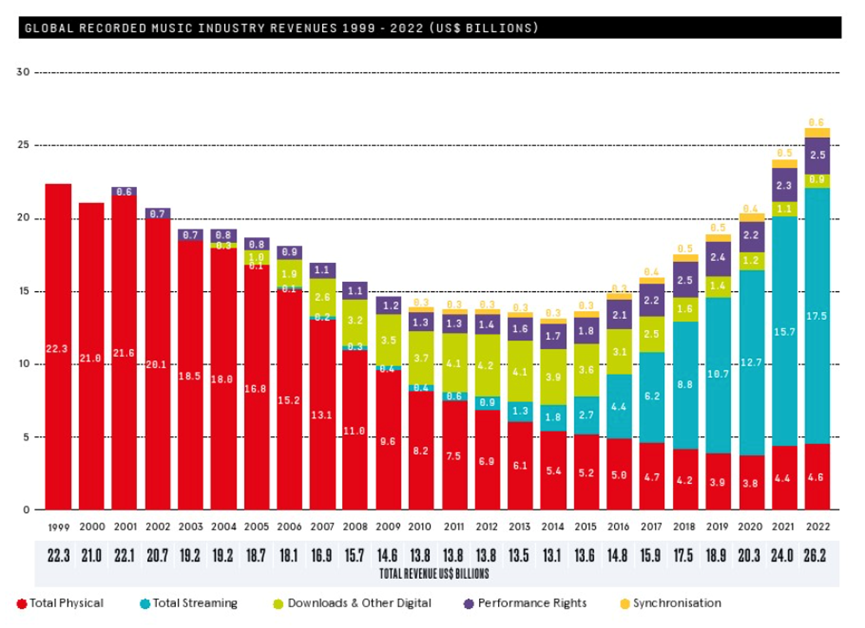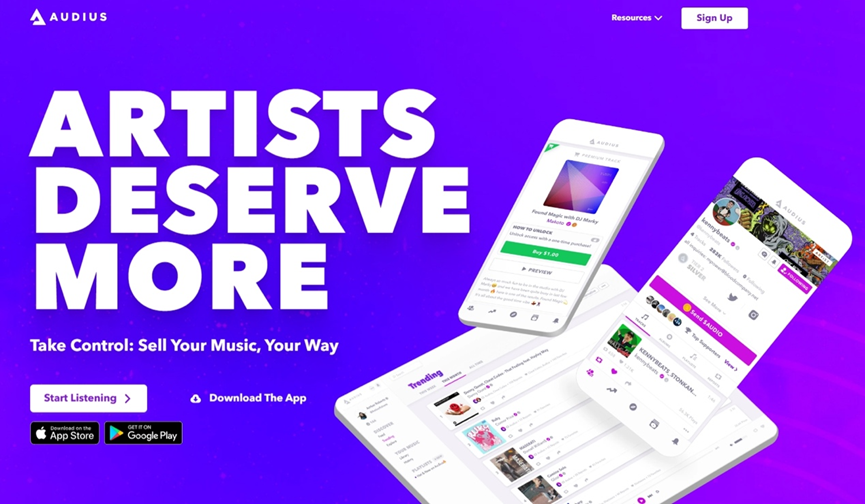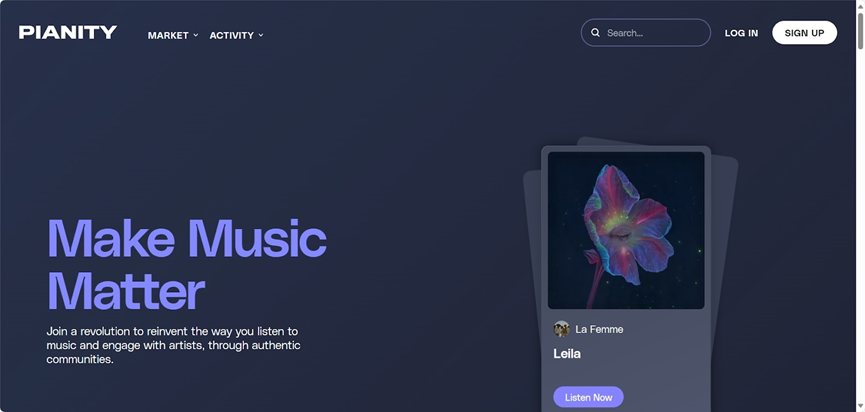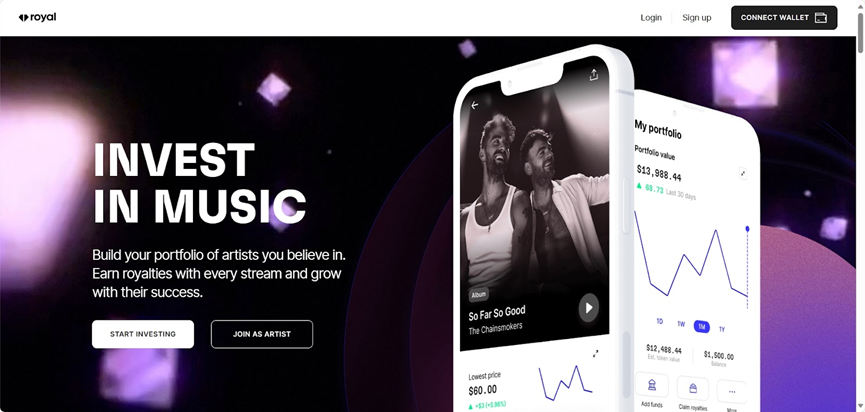Exploring the Future of Web3 Music: NFTs, AI, and Decentralization Composing Harmonies
Written by: @EdisonHuu
Mentor: @CryptoScott_ETH
I. Introduction
In a chaotic world, music is the refuge of the soul. It is an outlet for emotions and a balm for the spirit. In the melodies of music, we find resonance and touch the depths of feelings that cannot be expressed in words. Music, like a brush of time, adds color to the canvas of life, allowing ordinary days to shine with extraordinary brilliance.

Music is a carrier of emotions, capable of evoking deep emotional resonance within us, whether it be joyful songs or sorrowful elegies. A simple melody has the power to awaken memories hidden deep in our hearts, stirring up old smiles or tears. It is the key to our emotional world, opening doors to the depths of the soul.
Music is a bond of society and culture, a bridge that transcends language and cultural barriers. It conveys stories of different cultures and histories in its unique way, fostering understanding and connection among people. Every note carries the essence of culture, and every rhythm reflects the heartbeat of society. In the resonance of music, we not only discover our similarities but also learn to appreciate the wonderful differences.
Music is a comfort for the soul; on the journey of life, music is our constant companion. It provides solace in difficult times and companionship in joyful moments. When we feel lonely or lost, music is the light that illuminates the darkness, giving us strength and hope. It is a safe harbor for the soul, allowing us to find moments of tranquility amidst the turbulent waves of life.
Music is a spark for creativity; it is also a source of creative thinking. It inspires our imagination and challenges our innovative abilities. Music is not just a canvas for artists; it is a catalyst for the inner creativity of scientists, writers, entrepreneurs, and everyone. Inspired by music, we can break through the boundaries of thought and explore infinite possibilities.
In this diverse and complex world, music offers a unique perspective that allows us to feel the beauty and richness of life. It is indispensable because music not only touches our ears but also resonates with our souls.
II. The Music Industry Chain
The music industry chain is a vast and complex ecosystem. From the spark of inspiration to the birth of a song, from the meticulous production in the recording studio to global distribution, every step is crucial in the journey of music. Fundamentally, it is an ecosystem centered around creation, production, distribution, and consumption. In this system, every link is interconnected and interdependent.

Creation and Production:
Everything begins with creation, which includes songwriting, composing, arranging, and recording. At this stage, artists and creators are at the core. Then comes the production phase, which includes recording, mixing, mastering, and other technical processes. Crucially, this stage determines the final sound quality and style of the musical work.
Distribution and Dissemination:
The distribution phase is the process of bringing music works to the market. Traditionally, this mainly referred to releasing physical records (such as CDs and vinyl) through record companies. However, with the development of digital technology, this phase has shifted to digital streaming services and online music stores.
Evolution of Business Models:
In the past, the business model of the music industry primarily relied on record sales and live performances. Artists earned revenue through record companies and also made money from ticket sales for live performances. However, with the advancement of digitalization, streaming services have become dominant, changing the way revenue is generated. Nowadays, artists' income comes more from streaming royalties, live performances, and brand collaborations.
Copyright Management:
Copyright management occupies a crucial position in the music industry. It not only relates to artists' income but also serves as the foundation for the fair operation of the entire music ecosystem. In the digital age, while broader distribution channels have emerged, challenges in copyright protection and management have also arisen.
Market Trends:
According to the IFPI 2023 Global Music Industry Report, the global music market size reached $26.2 billion in 2023, a 9% increase from 2022, with revenue growth in every region's music industry. The recorded music market grew by 9% year-on-year, and the number of paid subscription users reached an astonishing 589 million. Currently, the music industry is undergoing rapid changes. On one hand, the rise of independent music has broken the market monopoly of traditional record companies; on the other hand, globalization and the proliferation of the internet have allowed music to transcend geographical boundaries and reach global audiences.

Source: IFPI 2023 Global Music Industry Report
III. Industry Pain Points
Despite the continuous expansion and development of the music industry globally, it still faces a series of profound challenges and pain points. These issues not only affect artists' earnings and creativity but also impact the healthy development of the entire industry.
Copyright Issues and Revenue Distribution:
Copyright issues have always been one of the core pain points in the music industry. With the popularity of digital music, copyright management has become more complex.
For example, the copyright dispute between renowned artist Taylor Swift and her former record company highlights the challenges artists face in protecting their work's copyright within the music industry. Additionally, the opaque revenue distribution mechanisms leave many artists feeling they are not receiving fair compensation, especially on streaming platforms.
Market Monopoly:
Market monopoly is another significant issue. The market dominance of major music labels and streaming platforms limits the development space for independent artists. This monopoly not only affects artists' income and exposure opportunities but also impacts the diversity of music.
For instance, independent artists often struggle to gain sufficient exposure on mainstream platforms, limiting their career development and creative freedom.
Artist Exposure and Marketing:
In the digital age, artists face increasing pressure for marketing and self-promotion. Artists signed with large companies may receive more market exposure opportunities, but independent artists must explore how to stand out in the complex digital world. This is not only a resource issue but also a skills and knowledge issue.
Challenges Brought by Digitalization:
While digitalization has brought broader reach and convenience to music, it has also introduced new challenges. Digital piracy and copyright infringement remain serious issues. At the same time, the popularity of digital music means that consumers' perception of music's value has changed, affecting pricing and sales strategies.
Music platforms, as the most crucial link in the entire music industry chain, also face significant challenges.
Complexity of Copyright Management and Revenue Distribution
- From the perspective of music platforms, copyright management is a huge challenge. It is necessary to ensure that all streamed music is legal while also handling the complex revenue distribution to relevant copyright holders.
- This process is particularly cumbersome and prone to errors for platforms that host a large number of independent musicians' works.
Market Monopoly and Artist Exposure
- Major music platforms often tend to promote already famous artists and popular songs, making it difficult for emerging artists and independent musicians to gain corresponding exposure.
- This market monopoly limits musical diversity and poses obstacles to innovation and the growth of emerging artists.
User Experience and Engagement
- Traditional music platforms typically offer limited user engagement options, primarily focusing on music playback and basic interaction features, lacking in-depth user participation and community building.
IV. How Web3 Addresses Industry Pain Points
Web3 technology, especially blockchain and the concept of decentralization, provides new perspectives and tools for solving existing problems in the music industry. The essence of Web3 music is to reshape the music industry chain, using blockchain technology to directly deliver the works of upstream artists as NFTs to downstream listeners, addressing copyright issues and improving revenue distribution. Let's explore the advantages of Web3 music.

Making Copyright Management and Revenue Mechanisms More Transparent
- Application of blockchain in copyright management: By utilizing blockchain technology, a transparent and tamper-proof copyright management system can be created. Every use and distribution of a music work can be recorded on the blockchain, ensuring that artists' copyrights are protected and they receive appropriate compensation.
- The role of smart contracts in revenue distribution: Smart contracts can automatically execute complex revenue distribution agreements. This means that artists and other rights holders can directly receive revenue based on pre-set rules, reducing intermediaries and improving the transparency and efficiency of revenue.
Breaking Market Monopoly
- Decentralized music platforms: Decentralized music platforms allow independent artists to directly release their works without going through major record companies or streaming services. This provides independent artists with more exposure opportunities while allowing consumers to access a broader range of music choices.
Artist Marketing and Exposure
- Community-based promotion models: On Web3 platforms, artists can leverage the power of the community to promote their music. Through tokenized incentive mechanisms, fans can directly participate in the promotion and distribution of music, forming a decentralized marketing model.
Addressing Digital Challenges
- NFTs and digital assets: By converting music works or experiences into NFTs, artists can endow their works with uniqueness and scarcity. This can serve as a new source of income and help reshape the value perception of digital music.
V. Overview of Targeted Projects
This section organizes existing Web3 music projects currently available in the market.
1. Gala Music
Gala Music is a decentralized music platform built using blockchain technology, enabling music artists to enhance their control over music and increase transparency in the industry chain, allowing fans to connect more closely with music artists.
Gala Music is an important component of the Gala ecosystem, which, along with Gala Games and Gala Movies, forms the cornerstone of the Gala ecosystem. It has currently issued the $Music token, with a market value of only $13 million.

2. Audius
Audius is currently the largest and highest-valued Web3 music platform by user count. It creates an open sharing ecosystem for music, where all music can be listened to for free, and it provides an open API for third-party products to access music, with rich music resources and low user thresholds.
The project launched its mainnet and the $AUDIO token in October 2020. The $AUDIO token reached a peak market value of $5 billion during the last bull market, and its current market value is around $200 million.

3. Pianity
Pianity is a music NFT platform built on Arweave, aimed at bringing together music artists and their communities to create, sell, buy, and collect limited edition songs.
Pianity not only views music as exquisite art but also provides services for artists to issue music NFTs, allowing artists to gain a new source of independent income. Pianity offers music NFT sales services and auction functions for artists and collectors. The ecosystem token has been designated as $PIA, which has not yet been issued.

4. Sound.XYZ
Sound.XYZ is an NFT music exploration and streaming platform on the Ethereum blockchain, providing a convenient wallet function and NFT trading avenues.
Currently, the project has raised $20 million in Series A funding, with artists such as Snoop Dogg, Daniel Allan, San Holo, Alexander23, and Vic Mensa on board. There is currently no token issuance.

5. Royal
Royal is a pioneering music marketplace on the Polygon chain, aimed at allowing fans to co-invest in music with artists and earn royalties, achieving shared ownership and mutual growth. It has received $16 million in seed funding from institutions like Coinbase and a16z, and $55 million in Series A funding, with artists such as 3LAU, JD Ross, The Chainsmokers, Nas, Kygo, and Loqic on board. There is currently no token issuance.

VI. Discussion on the Development Direction of Web3 Music
The application of Web3 technology in the music industry not only addresses existing problems but also brings new development directions for the industry. Here are several key areas of exploration, each accompanied by specific examples to deepen understanding:
1. The Combination of AI Music and Web3
Combining AI music creation technology with the decentralized and transparent characteristics of Web3 can create new music experiences and business models. AI-generated music works can be managed and traded on Web3 platforms. This combination provides new possibilities for the personalization and intelligence of music.
2. The Combination of MEME Culture and AI Music
AI music technology can be combined with popular MEME culture to create highly appealing and shareable music works. This combination can quickly gain popularity among young people, forming new music trends. AI can analyze popular online trends and user preferences to generate music that aligns with the current cultural context.
3. The Combination of DePIN and Music
Using decentralized storage solutions can ensure the security and permanence of music data. Combining decentralized computing platforms can efficiently perform inference and processing of AI music models. This technological combination helps reduce operational costs in the music industry while improving data processing efficiency and security.
4. The Combination of Creator Economy and Web3
Web3 platforms can provide music creators with more direct revenue channels and greater market control. Through decentralized markets, artists can sell their works directly to listeners without going through traditional music industry intermediaries. This will encourage more independent creation and promote diversity in the music industry.
5. The Combination of NFTs and Music
NFTs provide a unique ownership and trading method for music creation. Artists can create limited edition works or exclusive experiences by issuing NFTs of their music works, providing listeners with unique collectible value. In the future, NFTs may become an important way for music creation and distribution, especially for independent artists and experimental music projects.
6. The Combination of Fan Economy and Web3
In a Web3 environment, fans can support their favorite musicians by purchasing artists' tokens or NFTs. This model not only strengthens the connection between fans and artists but also provides fans with opportunities to participate in music creation and promotion, forming an interactive music ecosystem.
VII. Conclusion: The Future of the Music Industry and the Integration of Web3
Through an in-depth analysis of the music industry chain and its business models, as well as a discussion of current industry pain points, we can clearly see that the music world is at an important turning point. The introduction of Web3 technology not only provides innovative solutions to existing problems but also heralds new directions for the future development of the music industry.

- Integrating Innovation and Tradition
The core characteristics of Web3 technology, such as decentralization, transparency, data security, and smart contracts, open new pathways for solving long-standing industry issues like the complexity of copyright management and unfair revenue distribution. The application of these technologies can not only enhance the overall efficiency of the industry but also protect artists' creative rights, ensuring that their labor is fairly compensated.
- Building a Fairer Ecosystem
In the Web3 music ecosystem, artists, creators, and consumers will enjoy greater power and control. This new ecosystem helps dismantle the monopolistic structures of traditional industries, creating a more diverse and equitable environment for artistic creation and sharing. Artists will be able to connect directly with listeners, while consumers will have more opportunities to participate directly in music creation and promotion.
- Opening Up New Business Models
With the rise of NFTs, AI music, and decentralized platforms, the business models of the music industry will undergo revolutionary changes. These new models will not only increase artists' sources of income but also provide consumers with unprecedented music experiences and participation opportunities. From the collectible value of NFTs to the innovative potential of AI music, Web3 injects new vitality into the music industry.
- Looking Ahead
The future development direction of the music industry must adapt to the changing times, leverage intelligent technology, innovate music products and services, improve music quality and efficiency, protect music copyrights and income, meet the diverse needs of music consumers, and achieve sustainable development in the music industry. Although Web3 music is still in its early stages of development, its innovative model and solutions to traditional music industry pain points are essential pathways for all music companies seeking to establish a foothold and achieve sustainable growth in the music industry. When all foundational conditions are met, the explosive growth of the Web3 music sector is foreseeable.










